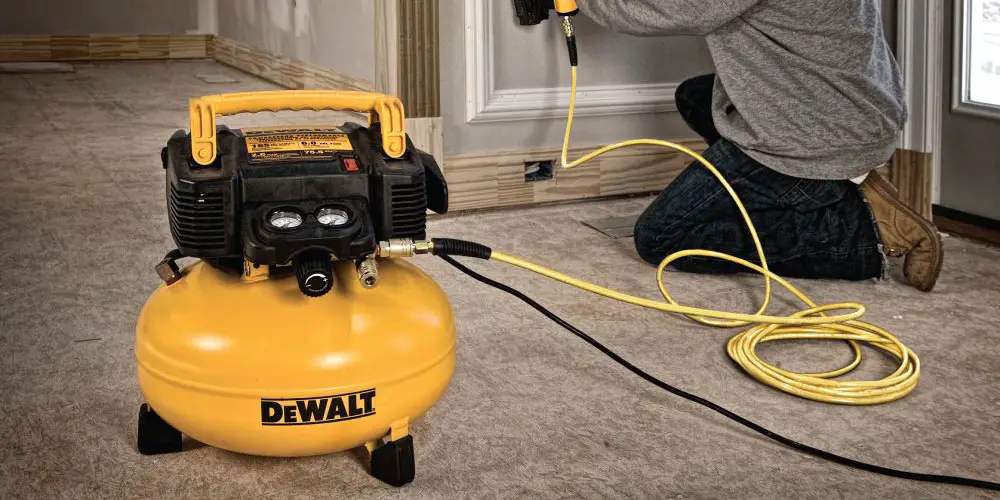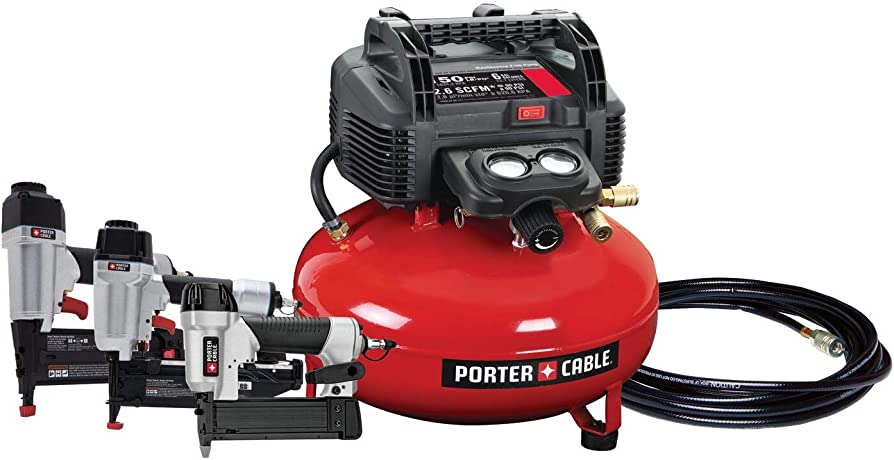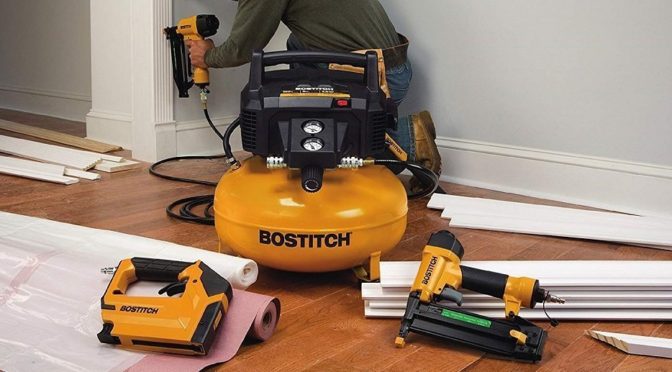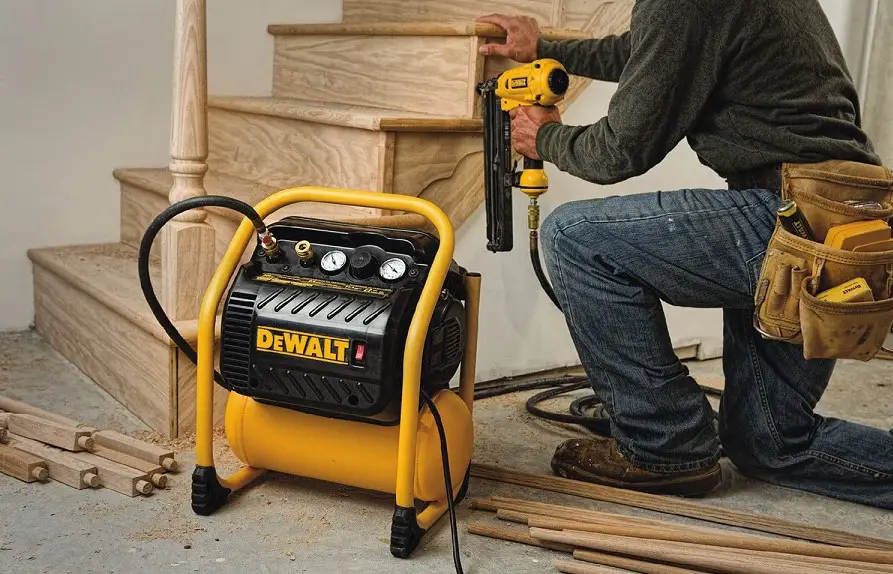What size air compressor for nail gun: a detailed answer
It could be difficult to determine the best air compressor for nail gun. Even if you understood what you were searching for, the terminology for an air compressor could be a bit too technical for the average person. But this article has put together a useful checklist of parameters to consider when determining an air compressor for a nail gun.
What is needed is a portable air compressor that has a tank size of two to six gallons and a minimum 2 cubic feet per minute rating.
Now, different criteria are needed based on how and what sort of nail guns are used.

List of criteria to consider when acquiring an air compressor for nail gun
When acquiring it, particularly because of pneumatic nail guns, what should you keep an eye out for? Here are factors to put into consideration.
The capacity of the tank
The depth of the tank will depend on how much utilization. Only if you intend to utilize the nail gun regularly does it make sense to invest in one that possesses a larger capacity tank.
The majority of them are built with a tank capacity ranging from one gallon to Eight gallons to operate pneumatic instruments, for instance, power nailers.
However, if you’re seeking portability and ease, particularly if you’ll be utilizing a nail gun, between one and six gallons ought to be adequate.
There are several advantages to possessing a larger tank. How much air can be taken down at any time will depend on the tank’s size.
The main premise is that if you possess a larger tank size, longer use of the air would be advantageous for you.
The air pressure will drop quickly if the air compressor’s tank is too small.
However, as was already noted, the size of the compressor would depend entirely on the task at hand. If you solely utilize the nail gun for everyday housework, a tank that has a lesser capacity would be perfect.
CFM
It indicates cubic feet per minute. Prioritize examining the depth of the tank and CFM before purchasing one. Essentially, if it has a 5 CFM rating, it could theoretically force a particular volume of air into a 5 cubic foot space in one minute.
And by doing so, one can ensure that the tool performs as expected and that the nail gun is compatible with the air compressor that is appropriate for its size. Multiply by 1.5 the needed cubic feet per minute to get the right cubic feet per minute for your nail guns. The calculated value is appropriate for the air compressor necessary for the particular tool.
Rather than constant air bursts, nail guns require brief ones, As a result, one with a capacity of two to four CFM should suffice.

PSI
It indicates pounds per square inch. The PSI symbol denotes air pressure per square inch of surface area. The majority of small air compressors from reputable brands provide enough Pressure to run air nail guns. As a result, you shouldn’t bother excessively about the PSI and instead should concentrate more on the CFM, the important component.
Naturally, having a high PSI offers advantages as well. In a tank of the same volume, more air may be held at a given pressure. For instance, if you have one with a 1-gallon tank and 150 PSI, a 1.5-gallon tank air compressor at 100 PSI would retain the exact air quantity.
A pressure regulator connects this tank to the hose supplying the nailer.
PSI and CFM work cooperatively. Assuming your air compressor fits the CFM and PSI settings, your tool will have a long-term advantage.
Additionally, it is advised that you purchase one with a higher PSI rating than what your nail gun requires. Adding 1.25 to the needed PSI will help you determine the appropriate PSI for your tool.
HP
HP denotes the air compressor’s horsepower. The overall power of your motor is represented by the HP of an air compressor. It simply states how much work the air compressor can accomplish in a certain amount of time.
The HP isn’t really important for small portable air compressors. The necessary horsepower will often be met by a compressor with sufficient CFM, PSI, and tank capacity.
Accordingly, a 5 HP air compressor is unable to do similar tasks as a 10 HP one. The fact that extra elements, such as its CFM and PSI, also come into play, 5 HP and 10 HP air compressors can deliver the same PSI at 10 CFM rates.
A 5 HP air compressor is more effective in this situation than the other, which is wasting energy.
Therefore, increasing HP does not necessarily increase efficiency, and the proper HP should be taken into account together with the tools’ CFM and PSI.

The air cooling system
Your air compressor will remain cold during the time you are using it thanks to an air-cooling system.
It improves the lifespan of your machines and pneumatic power tools in addition to cooling the system.
Sound level
Some of this equipment is loud. You could believe that this won’t make any difference much at first, especially if you simply use it for DIY or maintenance tasks regularly. However, after running the compressor a few times, this can become unpleasant.

FAQs:
You’ll need a nail gun that can fire 2 to 3-inch nails. Framing nail guns are perfect for working on fences and building decks because of their extended length.
Moving from portability to tank size, we now have an equal number of alternatives. However, the selection of sizes will be a bit limited because we’ve decided to only use portable compressors.
You know, portable air compressors have tanks that range in capacity from 2 to 20 gallons. The capacity for compressed air is the sole factor that matters. If you want to labor in a remote area all day, you might want a bigger air compressor tank. You might manage with a smaller tank if you are working in your garage.
A 6-gallon pancake compressor is what most contractors use. While still being portable and offering limitless nailing power, this is light enough to move around the work site.
The nail guns that are described here come in a variety of sizes. They are listed in order of smallest to largest.
Pin nailer: Small compressors with a one-gallon capacity and 2.0 CFM can be used with pin nailers.
Brad nailer: With a two-gallon tank and 2.0 CFM, a small compressor can power these kinds of nail guns well.
Finish nailer: Finish nailers work well with a compressor that has a two to three-gallon tank and 2.0 CFM.
Framing nailer: Use a four to six-gallon tank compressor capable of delivering 4.0 CFM for the best results.
Roofing nailer: For a roofing nailer, a compressed air tool with a six-gallon tank will do. Also, a roofing nailer will need between 2.2 and 2.5 CFM.
Remember that you will need something more powerful, such as a wheelbarrow air compressor that has a tank capacity higher than six gallons if you want to use the same compressor to run four or more of these nail guns simultaneously.
One of the quietest air compressors available when shopping online is California air tools. A strong oil-filled compressor will also often be quieter than a cheap pancake compressor.
Once you have the appropriate air compressor for framing nailers, your trip has only just begun. To master it like an expert, there are several variables that you must keep in mind.
Check out these crucial air compressor for framing nailer safety and usage tips.
Set the compressor’s pressure appropriately
Both CFM and HP determine the compressor’s power for each task. When utilizing an air tool, like a framing nailer, you do not necessarily need to use the highest power level.
Make sure the compressor is configured with the appropriate CFM and pressure for your framing nailer.
Choose the proper trigger
When it has to do with framing nailers, the trigger is the nail release mechanism. There are two kinds of triggers: single fire and bump fire.
The bump firing trigger is faster in terms of speed, but it lacks adequate control and precision. Single-fire triggering, on the other hand, is ideal for nailing with precision and control. However, it lacks the necessary speed for obvious reasons.
Examine the safety issues
When utilizing an air compressor with a framing nailer, several safety procedures and precautions must be taken into account. A nail’s enormous pressure and speed can be extremely harmful if it is pointed in the incorrect direction.
Watch out for any mechanical problems, including jammed nail heads, with your framing nailer.
There isn’t a universal answer to what size air compressor is needed, but there are some basic recommendations you may make when selecting an air compressor to run pneumatic tools.
There are light and heavy types of tasks that you can complete with air tools. In contrast to impact wrenches, which require a significant amount of power from the portable air compressor, a pneumatic framing nailer is far more pleasant and less demanding.
Therefore, be sure to consider the projects you plan to use the tools for. Is it only for huge construction projects or for domestic maintenance? If it’s a simple task, like fixing something in the backyard, a portable compressor will work just fine.
Instead, you need stationary air compressors or wheelbarrows for commercial and industrial projects.
This is one of the factors that affect the question we’re interested in. If you already own lightweight air equipment like an airbrush, sandblaster, or air hammer, the necessary compressor will be relatively inexpensive and compact.
On the contrary, if you use instruments like a jackhammer, air nailer, angle grinder, impact wrench, or brad nailer, you’ll need a considerably stronger air compressor. For obvious reasons, the expense will come afterward.
Tank size
The most adaptable term in the list of air compressor specifications will be its tank capacity. You will have a choice between sizes ranging from 1 gallon to more than 60 gallons, and making the best decision is never simple.
To function with air tools, it indicates how much-compressed air it could store and distribute. When the air in the tank runs out, the motor must then work once more to produce compressed air.
Certain air tools need a steady flow of compressed air. They include sanders, grinders, and other tools. They will therefore require a bigger air compressor tank for operation.
Short bursts of operation are used by tools with lower compressed air requirements. Therefore, a session using these tools will only require a few liters of compressed air. These tools can be identified by their shapes, such as framing nailers, brad nailer, etc. Additionally, this type of air compressor requires less power and less time for reloading.
Therefore, all that is required of you is to decide what kind of tools you will employ in conjunction with the compressors. Portable compressors with a capacity of 1–6 gallons will work if you just sometimes need to use pneumatic tools for minor or medium-sized tasks.
You can select an air tank size of up to 60 gallons if you require a continuous supply of compressed air for an extended period. But keep in mind that, proportionally speaking, the price and the power expense will be larger.
When you upgrade to a compressor with a 3-gallon tank, you will typically have enough power to complete any minor task. When you are traveling too quickly, a problem occurs. Using a framing nailer quickly might deplete the tank and make the air compressor work harder to keep up.
It is doubtful that you would overwork the compressor during the majority of DIY projects to the point where there would be a problem. If you’re concerned, go on up to a 6-gallon compressor because the extra air reserve will take care of the issue.
If you intend to install a lot of hardwood flooring, you’ll need more air and will value the larger tank size.
It is very likely that you’ll also be using other tools because the brad nail gun has such a limited range of tasks that it can complete. An increase in size is a finishing nail gun. It employs nails that are a little bit thicker and have a smaller head on them for better holding power.
Framing nail guns are much bigger than finished nail guns. Wall framing is accomplished with a framing nail gun. Additionally, home construction makes extensive use of the finishing nail gun.
You might want to acquire a compressor that is powerful enough to power all of these tools, so keep that in mind. So you’ll have a power supply for a framing nail gun, should you need to rent one.
Yes. The ideal size air compressor for powering a framing nailer is a 6-gallon unit. These are tiny air compressors that can be powered by any 120-volt outlet. They also feature a little bigger tank, which allows them to store more air.
Conclusion
The application must be the ultimate decider of air compressor size for a nail gun. A smaller machine will do the job if you just want to use one, or perhaps two, small nail guns with your compressed air unit. You need a compressed air unit with more power to run one large nail gun or three or four small ones. This is the only way to finish the job swiftly.
Read on site: Best Staplers for 50 Pages (2024)


What about the size of air hoses? My siding nailer isn’t fully driving the #6 RS SS nails through Hardi Board, or seasoned Hemlock framing using 1/4″ hose at 70 PSI.